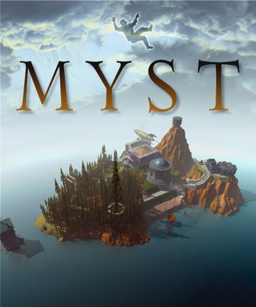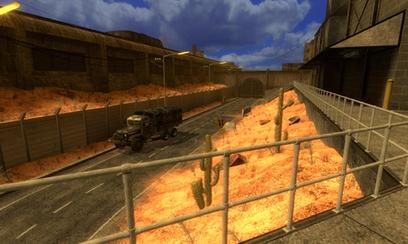There are invariably going to be weeks where I don't have time to play a new indie game to review. Already most of my reviews are of games that came out awhile ago. But for games that aren't strictly indie and/or came out years (sometimes decades) ago? Those are for the backlog.
This week: Myst.
 |
| MYST. |
Myst came out in '93 originally, which means you can be younger than it and still legally buy cigarettes, which makes me feel old. I was still a whelp when it came out, and three years or so after that I remember stumbling through it, trying to figure out how to get the piano in the spaceship to work, finding walkthroughs like a little cheat, marveling at the scenery. I never made it very far; I didn't have sound working, for some reason (The Selenetic age probably would have made me destroy my computer, had I ever made it there), and besides my little gamer-to-be brain wasn't equal to the endeavor yet. I played it again in high school and beat it on a Saturday morning, and now I'm playing through it again on my iPhone.
 |
| All that time and I still need a map to open a door. |
So, has this game, and this version of this game, been reviewed to death already? Sure. So here's why I'd like to talk about it:
-At the time it came out, it was revolutionary.
-Its use of visual art, music, and sound were, and still are, incredible.
-The story is deep and intriguing, the puzzles devious and clever, and the intersection of the two - the game's biggest puzzle, where you must come to understand that the task before you is not the task you should be trying to complete - is nothing short of brilliant.
-A game like Myst would be, from a technical standpoint, much, much easier to create now than it was in '93.
As people who love games, we should look at what Myst does well, and demand that of ourselves (as developers) and of the people we buy games from (as gamers).
There are a few points I'd like to make and elaborate on.
Myst artfully blends story, aesthetics, gameplay, and mechanics to deliver a unified experience. The principle idea of Myst is the ability to enter new worlds, and explore and interact with them, and everything in the game serves that idea. The story involves travelling to strange worlds through books, and asked a question of both the gamer and of the gaming community at large: What other worlds can you imagine, and what stories could take place there? The player-as-gamer could experience the same wonder at new worlds within computers that the player-as-character experienced at new worlds within books. The ability to move through lush environments by pointing and clicking, to turn wheels or pull levers by dragging them, to hear the waves near a dock or the hum of electricity or the rush of water though a pipe - all this was about making you feel like you were there. The game unified its component elements in the service of a single ideal, a task few games since have succeeded at so well.
Myst is not an especially long game.
Myst shows us something that many games (Skyrim, Final Fantasy, Mass Effect) help us forget, and that a few (Limbo, Braid, Portal) help us remember: that a short game can be as compelling, or more so, than a long one. It's been said that a work of art is perfect not when everything that has to be added has been, but when everything that is unnecessary has been removed. I can name a handful of games that have influenced me in my life, some shorter and some longer, but all of them felt like they showed only a glimpse of a much grander world - Braid with a "what-if" about changing the past, Shadow of the Colossus with its lonely wastes and obscure rituals and laws, Majora's Mask with its small-town charm overshadowed by perpetual menace. Myst made a promise - there is more to be seen, and to imagine. And the sequels delivered on that promise. Riven showed us a detailed study of the colonial implications hinted at in Myst. Exile showed us the utility, and danger, of being able to write any place you can imagine. And Revelation, which I almost prefer to the original, took us into the dark places that Myst's antagonists made their homes. But the first game showed us just a glimpse, and it's a beautiful view. When longer games, like Skyrim, appeal to me, it's always because there's so much to achieve, and so much to see, and it's all beautifully executed. When shorter games, like Myst, appeal to me, it's always because of the dreams and wishes they set spinning in my head, and it's in those places, usually, that I find anything like an authentic emotional experience.That, I suspect, is where we will begin to find art in games.
Myst is the sort of experience you could go make.
I hope by now you've got a sense of how much I adore Myst, and how highly I regard the people who made it. But it is dated; the technical limitations those developers were working with have been eliminated dozens of times over, and all the trails they blazed are now paved and carefully marked. You could, if you wanted, probably remake it in Unity. And then put it on an iPhone. What I'm getting at is this: If you go play Myst, and are as floored as I still am by the feeling you get looking through Atrus's library or opening the rocket ship door or looking over the trees in Channelwood, then take that feeling and go make a game with it. Create with it. Every time I play that game, I'm reminded how simple the tools involved are, and every time, I ask myself "Why am I going for anything less?"
I suppose this post is more for devs than it is for gamers. I don't want to make the claim that I'll ever make a game as good as Myst, and I think I've probably got a few bad games in me yet before I start getting at stuff that's really cool and meaningful. Yes, making a game is hard. Yes, there's a LOT of craftsmanship in Myst, and trying to emulate it, or to top it, is an incredibly tall order. Just remember that a game doesn't need to have cutting-edge, or even especially gorgeous, graphics. It doesn't need to look like Skyrim. It doesn't need to look like Wind Waker. It doesn't need to look like Braid. Play through Myst, whether for the first time or not, and just remind yourself that, of the many worlds it promised, only a fraction have been explored - and for any of the remaining worlds, you might be the first one to show it to us.














